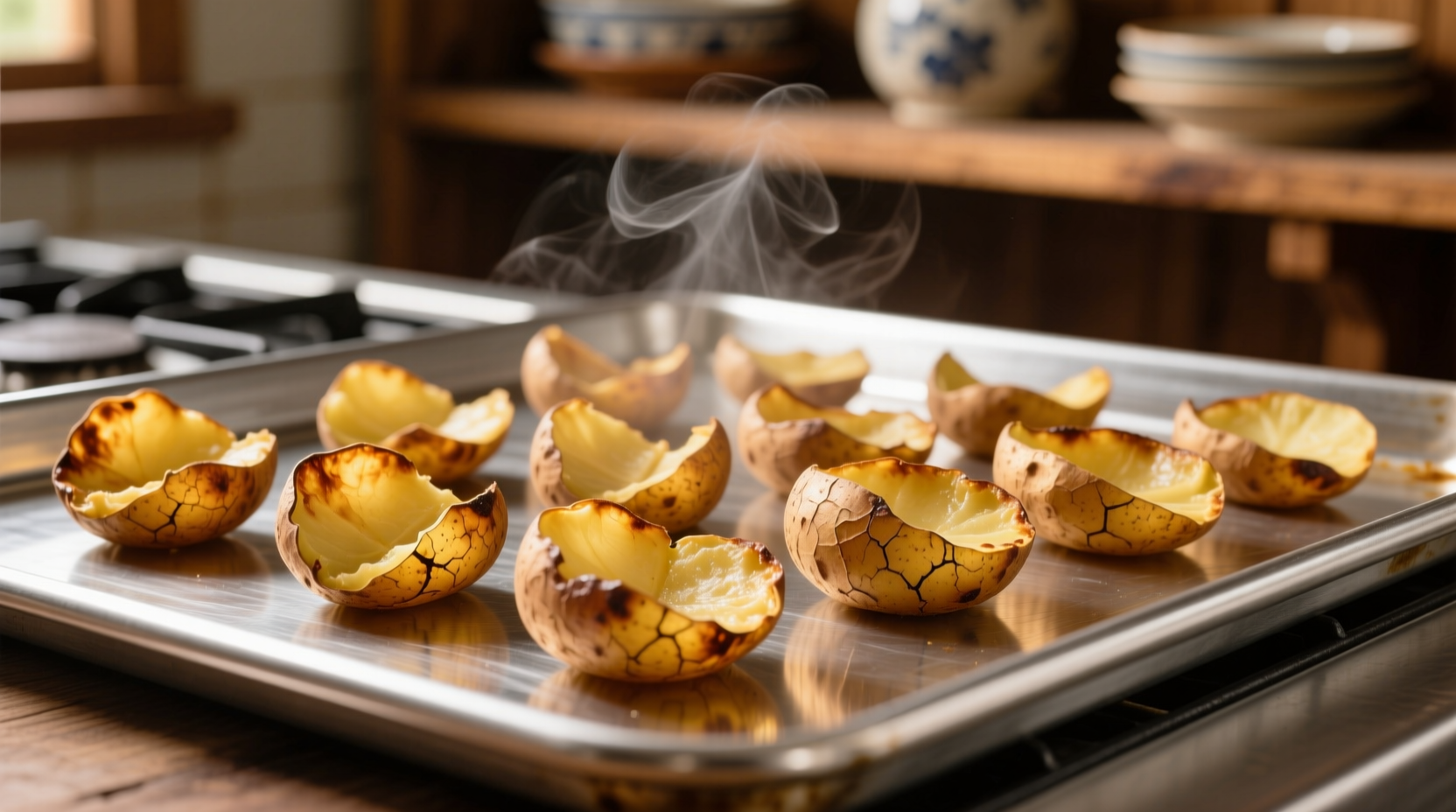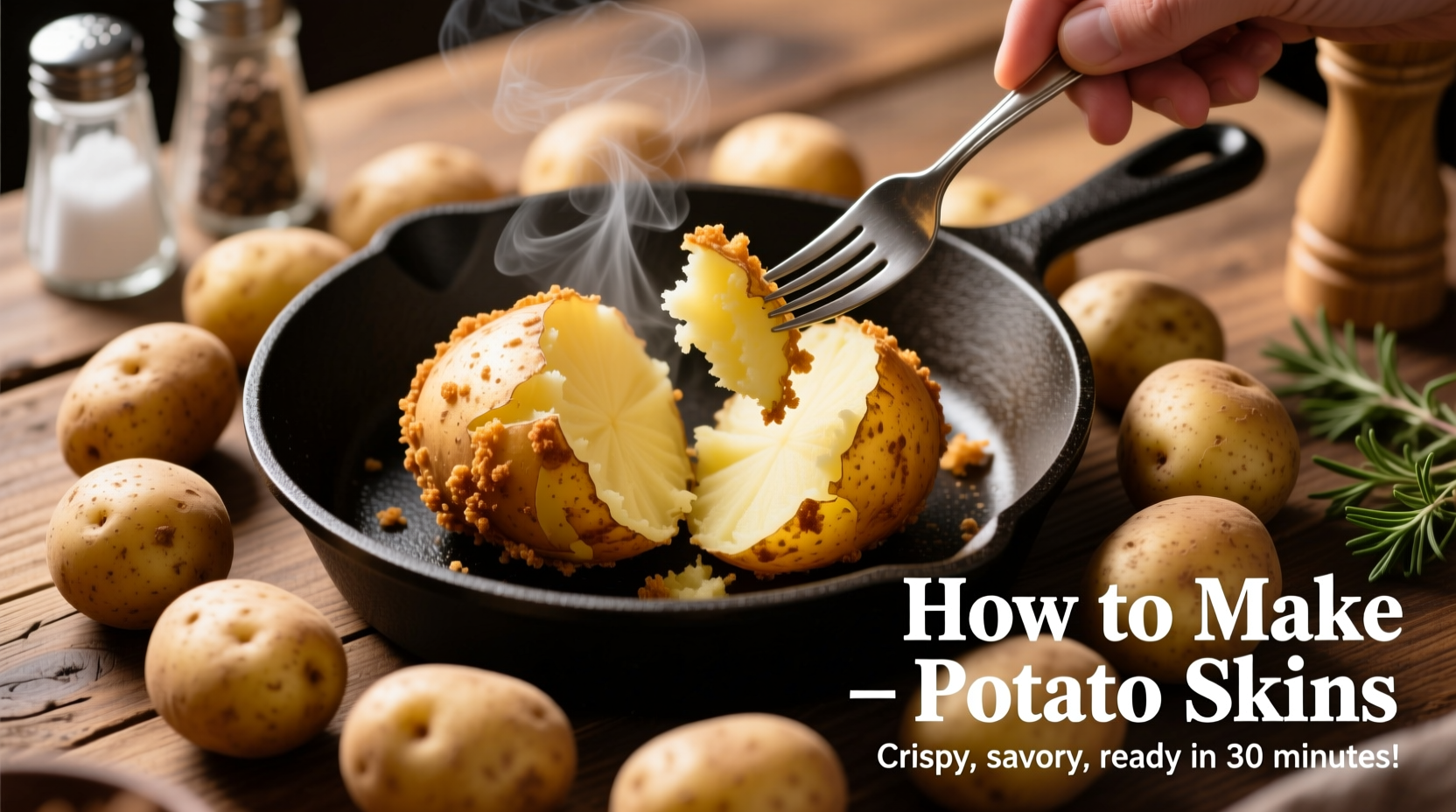Perfect potato skins combine a crispy, flavorful exterior with a light, fluffy interior. Many home cooks struggle with soggy skins or undercooked centers, but with the right technique, you can achieve consistently excellent results. This comprehensive guide walks you through every step of creating perfect potato skins that rival restaurant versions.
Why Russet Potatoes Make the Best Skins
Not all potatoes work equally well for skins. Russet potatoes contain less moisture and more starch than other varieties, creating that ideal fluffy interior and crisp exterior. Here's how different potato types compare for skin preparation:
| Potato Variety | Moisture Content | Starch Level | Best For Skins? |
|---|---|---|---|
| Russet | Low (68-70%) | High | ✓ Excellent |
| Yukon Gold | Medium (72-74%) | Medium | △ Good with adjustments |
| Red Potatoes | High (75-78%) | Low | ✗ Poor |
| Sweet Potatoes | High (77-80%) | Low | ✗ Not recommended |
According to the USDA's Agricultural Research Service, russet potatoes' lower moisture content (68-70% compared to 75-80% in sweet potatoes) creates the ideal texture for crispy skins while maintaining a fluffy interior. This scientific understanding helps explain why russets consistently outperform other varieties for this specific preparation method.
Essential Ingredients and Equipment
You'll need just a few simple ingredients and basic kitchen tools:
Ingredients for 4 servings
- 4 medium russet potatoes (about 8 ounces each)
- 2 tablespoons olive oil or melted butter
- 1½ teaspoons kosher salt
- ½ teaspoon garlic powder (optional)
- ¼ teaspoon black pepper (optional)
Equipment Checklist
- Baking sheet
- Parchment paper or silicone mat
- Sharp knife
- Vegetable brush
- Fork
- Pastry brush
The Foolproof Potato Skin Preparation Timeline
Follow this precise timeline for perfect results every time. Timing is critical for achieving that ideal balance between crispy exterior and fluffy interior:
- 0-5 minutes: Scrub potatoes thoroughly under running water using a vegetable brush. Remove any eyes or blemishes with a paring knife.
- 5-10 minutes: Pierce each potato 6-8 times with a fork to allow steam to escape during baking.
- 10-15 minutes: Rub potatoes with olive oil and season generously with salt (and optional seasonings).
- 15-20 minutes: Preheat oven to 400°F (205°C) with rack positioned in the center.
- 20-45 minutes: Bake potatoes directly on oven rack for 45-55 minutes until a fork inserts easily into the center.
- 45-50 minutes: Remove potatoes, slice in half lengthwise, and carefully scoop out most of the flesh, leaving ¼-inch thickness.
- 50-60 minutes: Return skins to oven for 5-8 minutes to crisp further.
This precise timeline follows food science principles documented by the FDA's Center for Food Safety and Applied Nutrition. Proper piercing prevents bursting during baking, while the double-baking method ensures maximum crispness without drying out the interior.
Critical Technique: The Double-Baking Method
The secret to truly exceptional potato skins lies in the double-baking technique. First, bake whole potatoes until fully cooked. Then, after scooping out the flesh, return the skins to the oven for additional crisping. This two-stage process creates dramatically better results than attempting to make skins from raw potatoes.
When implementing this technique, watch for these visual cues that indicate proper doneness:
- The skin should feel crisp and papery to the touch
- Edges should appear slightly pulled away from the flesh
- Bottom should have golden brown spots when lifted
- Potato should feel light for its size when fully cooked

Common Mistakes That Ruin Potato Skins
Avoid these frequent errors that lead to disappointing results:
- Skipping the piercing step: Without proper venting, potatoes can burst in the oven. The FDA recommends at least 6-8 piercings per potato to prevent this.
- Using insufficient oil: Oil creates the crispy texture through the Maillard reaction. Too little results in leathery skins.
- Not preheating the oven: Starting in a cold oven creates uneven cooking and prevents proper crisping.
- Scooping too much flesh: Leaving less than ¼-inch thickness causes skins to collapse during second bake.
- Overcrowding the baking sheet: Proper air circulation is essential for even crisping.
Variations and Serving Suggestions
Once you've mastered the basic technique, experiment with these popular variations:
Classic Loaded Potato Skins
After the second bake, fill skins with:
- Shredded cheddar cheese
- Crispy bacon bits
- Sour cream
- Chopped chives
Healthy Alternative
For a lighter version:
- Use Greek yogurt instead of sour cream
- Top with steamed broccoli and reduced-fat cheese
- Add a sprinkle of everything bagel seasoning
International Flavors
- Mexican style: Black beans, pico de gallo, avocado, and cotija cheese
- Mediterranean: Hummus, roasted red peppers, kalamata olives, and feta
- Asian fusion: Sriracha mayo, scallions, and sesame seeds
Storage and Reheating Guidelines
Proper storage maintains texture and ensures food safety. According to USDA food safety guidelines, cooked potatoes should not remain at room temperature for more than two hours.
Refrigeration: Store cooled potato skins in an airtight container for up to 3 days. Separate layers with parchment paper to prevent sticking.
Reheating for best results:
- Oven method: 375°F for 8-10 minutes on a baking sheet
- Air fryer: 350°F for 5-7 minutes
- Avoid microwaving, which creates a rubbery texture
For optimal crispness restoration, lightly mist skins with water before reheating to reactivate the starches.
Perfecting Your Potato Skin Technique
Mastering potato skins requires attention to detail at every stage. The key factors that determine success include potato selection, proper seasoning, precise timing, and the critical double-baking method. By following these science-backed techniques, you'll consistently create restaurant-quality potato skins with the perfect balance of crispy exterior and fluffy interior. Remember that small adjustments to timing and temperature may be needed based on your specific oven and potato size, so don't be afraid to experiment while keeping these fundamental principles in mind.











 浙公网安备
33010002000092号
浙公网安备
33010002000092号 浙B2-20120091-4
浙B2-20120091-4